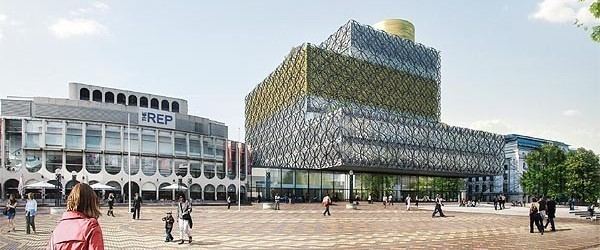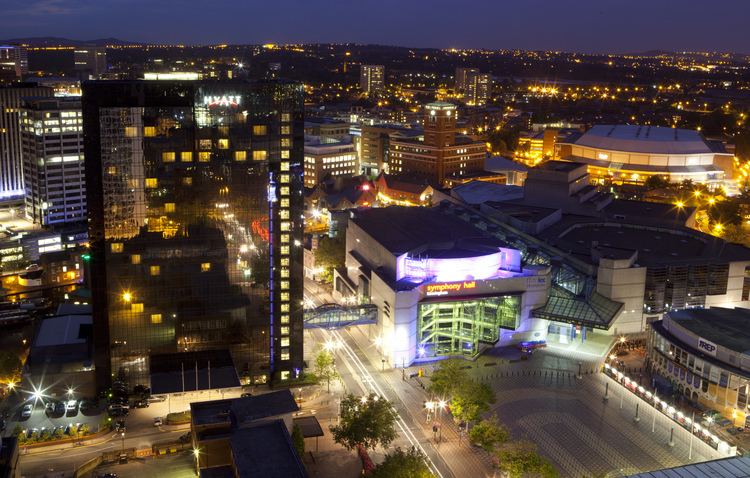 | ||
The uk today walking through birmingham city centre march 2016
Birmingham city centre is the business, retail and leisure hub of Birmingham, England. Following the removal of the Inner Ring Road, the city centre is newly defined as being the area within the Middle Ring Road. Birmingham City Centre is undergoing massive redevelopment with the Big City Plan. This means there are now nine emerging districts and the city centre is approximately five times bigger.
Contents
- The uk today walking through birmingham city centre march 2016
- Let s go for a drive birmingham city centre canon 60d
- Districts
- Major stores
- City centre core
- Places of interest
- Education
- Transport
- Sport
- References

Let s go for a drive birmingham city centre canon 60d
Districts
Major stores

Following the removal of the Inner Ring Road, which acted as a "concrete collar" "under which pedestrians would be forced to walk through intimidating, dark and stinking underpasses" and prevented the expansion of the city centre, a massive urban regeneration project known as the Big City Plan has begun.

Running through the city centre is the Birmingham Fault, a sandstone ridge. The "High Places" document produced and published by Birmingham City Council encouraged the construction of highrise buildings on the ridge.
City centre core

The city centre core is the historic heart of the city, where old and new features are juxtaposed, roughly bounded by the former Birmingham Inner Ring Road. Its pre-eminent features include: Chamberlain Square, Old Square, Victoria Square, Birmingham Town Hall, Birmingham Museum and Art Gallery, Birmingham Central Library, St Philip's Cathedral, Methodist Central Hall, Victoria Law Courts and other Birmingham Law Courts.
City Centre Core streets include: New Street, Corporation Street, Colmore Row and Dale End.
Places of interest

The city centre contains many tourist destinations as well as landmarks. Brindleyplace, a regeneration scheme by Argent Group PLC, regenerated an area of derelict warehouses alongside canals near Broad Street. Brindleyplace consists of three public squares, offices, retail units and the Sea Life Centre. Oozells Street Board School was refurbished to become the Ikon Gallery. On the opposite side of Broad Street Tunnel on the canal network is Gas Street Basin. Nearby is also the International Convention Centre and Birmingham Symphony Hall, which is considered one of the best performance venues in the world. This overlooks Centenary Square and is adjacent to the Birmingham Repertory Theatre. Centenary Square was redeveloped in 1989 and given its current name in that year. Within Centenary Square is the Hall of Memory and Baskerville House.

Other public squares in the city centre include Victoria Square, Chamberlain Square and Old Square. There are two public squares within the Bull Ring complex and another in the Custard Factory.
Retail is mainly focussed on the Bullring Shopping Centre, Corporation Street, New Street and High Street. There are other shopping centres in the city centre such as The Mailbox on Suffolk Street and the Pallasades Shopping Centre above New Street station. Great Western Arcade is one of several arcades in the city centre. Digbeth is the focus for many independent retailers. Broad Street is the main centre for Birmingham's nightlife. There are further nightclubs in Digbeth.
Cultural attractions include Birmingham Central Library in Chamberlain Square and Birmingham Museum & Art Gallery and the Council House, Birmingham in the same building together with the clock tower, Big Brum. Thinktank opened in the Millennium Point complex in Eastside in 2002, replacing the Museum of Science and Industry on Newhall Street. The history of the Jewellery Quarter is documented in the Museum of the Jewellery Quarter. Also in the Jewellery Quarter is the Royal Birmingham Society of Artists and St. Paul's Gallery. A group of back-to-back houses on Hurst Street were restored by the National Trust. The Birmingham Back to Backs are the last surviving court of back to back houses in the city.
Colmore Row is the centre of the Colmore Row and Environs Conservation Area which consists of St. Philip's Cathedral. The Jewellery Quarter is also covered by a conservation area. Other quarters in the city centre are the Chinese Quarter, Irish Quarter and Learning and Technology Quarter.
Education
Aston University is based in the city centre whilst Birmingham City University has educational facilities there. In the Eastside area is Matthew Boulton College which moved from its previous location alongside Belgrave Middleway in 2005. Near this, is the New Technology Institute, which opened in 2006. Birmingham Ormiston Academy is also located on the edge of the centre.
Round this area are many high rise buildings providing student accommodation as well as high rise educational buildings.
Transport
Birmingham New Street station is the main railway station in the city centre with local and national railway connections. The station was first built in 1854 and rebuilt in 1967. The redevelopment of the station in a project named Gateway Plus was finished in 2016.The project cost £600m and includes a new John Lewis department store and many other shops. The project took 5 years to build and is one the most expensive and controversial regenrations in all of Europe. Birmingham Moor Street station, Birmingham Snow Hill station, Bordesley railway station and Jewellery Quarter railway station are also located within the city centre. Ten suburban and Inter-City heavy rail routes service the city centre. The first railway station to be built in the city centre was Curzon Street railway station, which acted as the terminus for both the London and Birmingham Railway and the Grand Junction Railway, with lines connecting Birmingham to London and to Manchester and Liverpool respectively. The building, designed by Philip Hardwick, was built in 1838 and is Grade I listed.
The Midland Metro system, opened in 1999, terminates at Snow Hill station and has stops at St Paul's and the Jewellery Quarter. There are plans to extend Line One into the city centre to New Street station and on to Five Ways. In 2007, construction of a new viaduct to carry the Midland Metro line over Great Charles Street Queensway commenced. The viaduct is being built by the developers of Snowhill adjacent to Snow Hill station. The viaduct will be turfed over until the funding for the extension and planning permission have been granted. Birmingham City Centre used to have a trolleybus system in the 19th century and early-20th century which extended towards the suburbs.
The trolleybus system was replaced by motor buses and the city centre is now the hub for the bus system in the city. The buses mainly terminate at Bull Street, Corporation Street and Moor Street, Queensway. The majority of these buses are operated by National Express West Midlands. The city centre is also the hub for the national coach network. Digbeth Coach Station, which is currently in the process of being prepared for redevelopment, is owned and operated by National Express who are to move their headquarters to the city. It was built by Midland Red in 1929, and until 1997 was also used by Midland Red West as a depot. The shed to the rear of the coach station has been demolished and Spencer House, the office building above the main waiting room, has been boarded up. A planning application for the refurbishment of the building has been submitted and is awaiting planning permission. A temporary coach station on the opposite side of the road is currently being used.
Cars are not officially encouraged in the city centre. Some areas have been pedestrianised to prevent cars interfering with pedestrian traffic, and some roundabouts with pedestrian subway systems have been replaced with signal-controlled junctions, e.g. on Smallbrook Queensway, Moor St Queensway, James Watt Queensway and St Chad's Circus near St Chad's Cathedral. However, there are still the remnants of the Birmingham Inner Ring Road (Queensway) in existence despite much demolition and downgrading, with a de facto heavily trafficked "half-ring" with vehicular underpasses for through traffic on St Chads Queensway, Great Charles St Queensway and Suffolk St Queensway. Some at-grade pedestrian crossings go over these roads, but most remain subways or bridges. This "half-ring" does arguably reduce traffic in other parts of the city centre, however.
There are numerous multi-storey car parks located within the city centre, most owned by private companies. A new multi-storey car park is proposed at the rear of Millennium Point whilst the demolition of the multi-storey car park on Dale End has been granted permission by the city council as part of the Martineau Galleries redevelopment by the Birmingham Alliance.
Sport
The city centre is the location for the Barclaycard Arena, which is operated by the NEC. The indoor arena has hosted many national and international sporting events, as well as music concerts.
